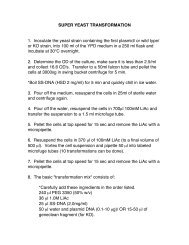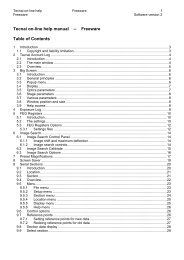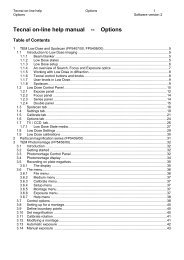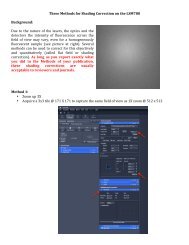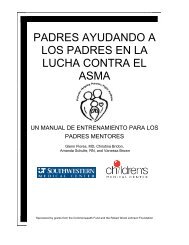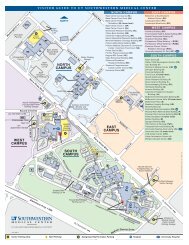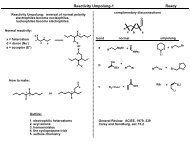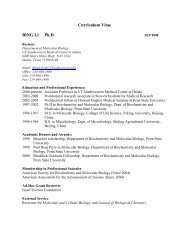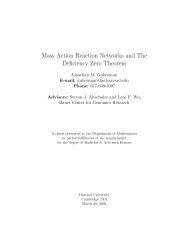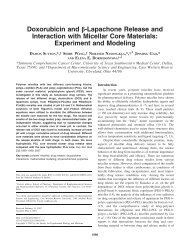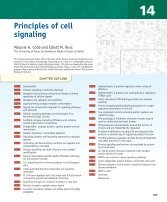Tecnai on-line help manual -- Alignments - UT Southwestern
Tecnai on-line help manual -- Alignments - UT Southwestern
Tecnai on-line help manual -- Alignments - UT Southwestern
- No tags were found...
Create successful ePaper yourself
Turn your PDF publications into a flip-book with our unique Google optimized e-Paper software.
<str<strong>on</strong>g>Tecnai</str<strong>on</strong>g> <strong>on</strong>-<strong>line</strong> <strong>help</strong> <strong>Alignments</strong> 62<str<strong>on</strong>g>Tecnai</str<strong>on</strong>g> 12 Software versi<strong>on</strong> 2Notes:• It is useful to activate the Scope functi<strong>on</strong> <strong>on</strong> the STEM Imaging C<strong>on</strong>trol Panel. This functi<strong>on</strong> displaysthe detector signal levels <strong>on</strong> a fixed scale and thereby makes it easier to judge the alignment (theSTEM image has its c<strong>on</strong>trast and brightness re-adjusted after an image has been collected, whichmakes it difficult to judge the signal levels from the detector).• The near-axis positi<strong>on</strong> (where the STEM Bright-Field/Dark-Field detector assembly is located) is at~30 mm from the screen center to the ENE (slightly away from the screen center to the top right).This physical positi<strong>on</strong> is of course the same for all camera lengths but the actual diffracti<strong>on</strong> shiftsrequired to get there depend <strong>on</strong> the camera length (which magnifies the diffracti<strong>on</strong> shift), so thesettings are dependent <strong>on</strong> the camera length.• Because hysteresis can have c<strong>on</strong>siderable effect <strong>on</strong> the diffracti<strong>on</strong>-pattern positi<strong>on</strong>, you should usethe normalizati<strong>on</strong> facility whenever the optical c<strong>on</strong>diti<strong>on</strong>s have changed (the automaticnormalizati<strong>on</strong>s take care of this, so it is advised to keep them enabled).• Some of the lowermost camera lengths are too small to reach the near-axis detector (typically thecamera length must be at least 90 mm). There is no point in trying to align these. Simply go <strong>on</strong> to thenext camera length.• Some of the large camera lengths will overlap the bright-field disk <strong>on</strong>to the dark-field detector and aretherefore of little use. You can skip these camera lengths as well.• When the camera length changes, the signal <strong>on</strong> the detectors will change, so it will be necessary toadjust c<strong>on</strong>trast and brightness. For this purpose, the alignment procedure makes it easy to switch todetector c<strong>on</strong>trol by pressing R2 (toggle between detector alignment and BF detector c<strong>on</strong>trol).• Since the size of the C<strong>on</strong>denser aperture determines the beam c<strong>on</strong>vergence angle, it alsodetermines the size of the diffracti<strong>on</strong> disks and thereby what the effective camera lengths are forBF/DF imaging (if the central beam is too large, it will fall <strong>on</strong> the DF detector). To determine if thebeam doesn't have l<strong>on</strong>g tails due to the combined effects of spherical aberrati<strong>on</strong> and largec<strong>on</strong>vergence angles (and thus poorly defined spots), you can observe the focused beam innanoprobe mode (for the particular c<strong>on</strong>denser aperture). Normally the two smallest c<strong>on</strong>denserapertures are the <strong>on</strong>es that are suitable for STEM.• Some camera lengths are difficult to use at low STEM magnificati<strong>on</strong>s because the sphericalaberrati<strong>on</strong> of the diffracti<strong>on</strong> lens makes it impossible to have the diffracti<strong>on</strong> remain sufficientstati<strong>on</strong>ary to keep it <strong>on</strong> the detectors (the pattern described by the central-beam disk looks like a birdflying, with its wings flapping up and down). Either use higher magnificati<strong>on</strong>s or other camera lengthsin those cases.12.8 HM-STEM Distorti<strong>on</strong> adjustmentPurpose: Adjust the AC deflecti<strong>on</strong> coils settings so that the resulting STEM image has no distorti<strong>on</strong>s.Importance: ESSENTIAL for proper STEM imaging.Method: Collect an image of a cross-grating and adjust the relative strength of X and Y coils, and theirperpendicularity.Important:• The specimen must be at the eucentric height. To do this properly, go to the Nanoprobe mode andpress the Eucentric Focus butt<strong>on</strong>. The objective lens current is now set to the proper value forNanoprobe (provided the SA objective preset has been aligned properly). Then bring the specimeninto focus with the Z height of the specimen stage. (By doing it this way you will attain a morereproducible setting than by using the alpha wobbler.)• During STEM alignment TIA (Tem Imaging & Analysis) must be running.



